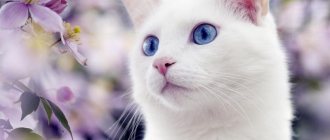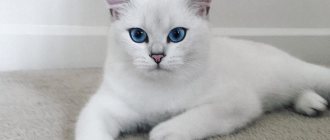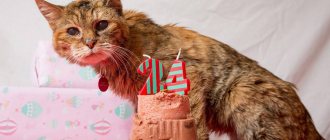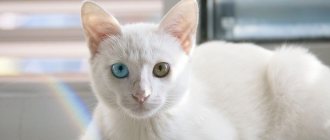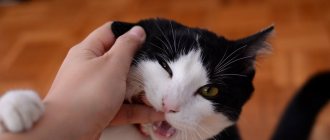Gray cats have always been the center of attention, and their silver-blue coat has long been associated with moonlight and was considered a sign of aristocracy. And today, animals with a smoky color are recognized as the personification of internal harmony and emotional stability. It is not surprising that they are in great demand among ordinary owners and professional breeders.
Let's find out which cat breeds are characterized by gray fur.
Features and genetics of color
The blue shade of wool is a lightened version of black. It manifests itself when certain conditions are met, which is why there are much fewer gray cats than patterned or dark ones. To obtain blue coat color, the kittens need to inherit from both parents the lightening gene and the non-agouti gene, which is responsible for suppressing the manifestation of the pattern.
In addition to the completely gray color, which completely lacks red pigment, cats have a so-called lilac color. Individuals with this coat have a dominant “red” gene, which gives their coat a warm tint.
From a genetic point of view, gray cats have a dominant black gene B (Black), diluted with a recessive light gene d. Under the influence of the latter, the carbon pigment zumelanin is unevenly distributed in the hairs. White spaces appear between the sticky granules, which create a brightening effect. The more black pigment a cat's hair has, the darker the color and vice versa.
Sometimes a mutation occurs in which charcoal is concentrated in the lower part of the hair, and its tip is colored white and vice versa.
Little white kitten: photo
An animal at home, especially if it is a small, fluffy ball, is the most touching and gentle creature. And it's even better if it's white. You don't often see kittens like this. They are very sweet and touching. Besides being fluffy and playful, like all little kittens, they are also very elegant and attractive.
They require special care, especially for their white coat. Proper maintenance and use of special products will help maintain the snow-white color of a kitten’s coat and even that of adult cats.
Breeds for which only gray coat color is acceptable
Among the varieties of cats, there are those that are characterized only by an ash-colored coat. These breeds include:
- Russian blue;
- chartreuse;
- Nibelung;
- korat
Russian blue
Representatives of this breed are medium in size and have a slender build. But the main feature of Russian blue cats is considered to be their unique color, emphasizing the bright green color of their eyes. Their coat has silver ticking, which gives their short, thick coat a snowy effect.
According to the standard, a Russian Blue cat must have uniform fur without yellowness, streaks or inclusions.
Chartreuse
These are large, well-built cats with well-developed muscles, a cheeky muzzle, a round head and small ears. Their soft, plush coat with a thick undercoat is colored only a uniform gray.
Blue cats' irises can be dark orange or bright yellow. And each chartreuse paw has soft gray-blue pads.
Nibelung
This is a long-haired variety of Russian Blue cats that has inherited all the characteristics of its ancestors with the exception of the structure and length of the fur. The Nibelungs got their name (translated from German as “creature of fog”) due to the unique color of their fur coat.
The thin silky coat of the breed is colored blue, in harmony with the green eyes. According to the standard, these gray cats have weak ticking.
Korat
These elegant gray cats were brought to Europe from northern Thailand over a hundred years ago and were long considered a cull of the Siamese. Korats are medium in size, flexible muscles and have an unusual heart-shaped head.
The hallmark of the breed is its olive-green eyes and short, silky coat, the color of which varies from blue-gray to lavender.
Health
Russian Blue is a natural breed with strong immunity and good health. The life expectancy of the animal is up to 20 years. Shows activity until old age. The cat rarely gets sick and tolerates temperature changes well. Not afraid of drafts. Genetic diseases are not typical for this breed, but the cat suffers from some ailments.
Ritotracheitis is an infectious disease with fever, eye damage and catarrh of the respiratory tract. Accompanied by a runny nose, rash, and lacrimation. It does not appear immediately; the Russian Blue can be a carrier of the virus for many months and release it into the environment. The causative agent of the disease is type I herpesvirus.
Infection occurs through nasal and oral secretions from a sick animal. The virus is brought into the house by a person, and the cat becomes infected through objects around it. Ritotracheitis is a serious illness that can be treated with antibiotics. If measures are not taken in time, the animal will die.
Food allergies are common in Russian Blues. The pet becomes lethargic, the skin turns red, itches, and the general condition worsens. Other symptoms cannot be excluded:
- the appearance of blisters;
- nasal discharge, otitis media;
- vomit;
- diarrhea.
The problem develops with the accumulation of the allergen product in the animal’s body. Basically it's protein. A reaction to beef, egg yolk, or fish may not appear for months. The allergy makes itself felt by the age of one year. The allergen product is determined and excluded from the diet, and general strengthening measures are taken to stabilize the condition.
The breed suffers from skin diseases. The Russian Blue has a beautiful thick coat - an indicator of its excellent health. Baldness indicates a malfunction of internal organs.
The most common causes of baldness in Russian Blues are:
- development of infectious diseases;
- hormonal disorders;
- allergic reactions.
The basis of treatment is to eliminate the causes of baldness. Timely combing of your pet’s fur plays an important role.
An unbalanced diet and restrictions on movement lead to extra pounds (obesity). This is fraught with heart problems and diabetes. It is important to maintain a feeding schedule, eliminate snacking, and encourage physical activity.
Russian Blues are vaccinated against many diseases from 10-12 weeks of age. The first two months after the birth of kittens are protected by the mother's immunity.
Vaccination against the following diseases is mandatory:
- calicivirus;
- rhinotracheitis;
- ringworm;
- rabies;
- panleukopenia.
The interval between vaccinations is 1 month. In front of them, the cat takes an anti-worm medication.
Other breeds of gray cats
In addition to varieties in which the standards allow only a gray coat color, there are breeds for which this shade is not the only possible one.
British
These large, squat cats with a round muzzle, broad chest and plump cheeks have a matte, dense coat with a thick down. The British standard allows for many color options, including any shades of gray. But most breeders give preference to individuals with a light blue coat.
According to the standard, a British gray cat should not have undyed hairs, rust, tabby markings, iridescence or patterns on the coat.
Scottish
Representatives of this cat breed are closely related to the British. They can be straight or fold-eared, and have short or long hair. The Scots have many different colors, but the most interesting is light gray fur with a blue tint.
Defects include colored blotches and uneven coloring of the coat.
Persian
The fluffy cat with a flattened muzzle and upturned nose is medium-large in size and has a luxurious silky coat. The Persian's luxurious long fur comes in different colors. But the most popular are those with blue fur.
According to the standard, a Persian gray cat must have a uniform color without spots or inclusions.
American Curl
This beautiful, harmoniously built cat with original ears turned outward can have either short or long hair, which has a soft elastic texture. The American Curl has practically no undercoats. And the color range of gray cats varies from dark gray to light blue tones.
Siberian
According to the standard, Siberians are allowed more than 200 color options. But the most spectacular are individuals with bleached blue fur without spots or splashes of a different color. The nose and paw pads of gray cats of the Siberian breed should be in harmony with the tone of the fur coat.
Turkish Angora
When this breed is mentioned, a blue-eyed white cat with semi-long hair pops up in the subconscious of many people. And indeed, at first the Angora population consisted of just such individuals. But then white cats with blue eyes began to rapidly lose popularity and experts had to expand the acceptable color palette of animals.
Thanks to the efforts of breeders, gray cats with copper or green eyes appeared among the representatives of the breed. The nose and paw pads of angoras with this color are pigmented blue.
Ragamuffin
This big, friendly cat comes in many color options. Light blotches are allowed on the blue fur of the Ragamuffin. And gray cats with blue or green eyes are subject to culling.
Maine Coon
The cat of this breed is distinguished by its impressive size and sociable disposition. An adult Maine Coon can weigh up to 8-12 kg. It has a fluffy tail and neat tufts on its ears, and its fur can be dyed almost any color.
Gray cats with emerald green or lemon eyes are especially popular among European breeders. Individuals with flowing, rich, ash-colored fur exude a special magnetism and look more mysterious than their black-and-white or red counterparts.
Egyptian Mau
The coat of these cats can be a silvery-smoky color with a spotted pattern.
Australian smoke
These short-haired animals are endowed with an affectionate, good-natured disposition. Australian Smoke cats have beautiful fur with a unique coloring that consists of a background, a dark pattern and a haze.
Asian smoky
The Asian Smoky cat is a smooth-haired cat. Its beautiful blue-gray coloring harmonizes with amber or yellow eyes. And the light undercoat creates moire tints. When the Asian Smoke Cat moves, its fur appears to shimmer.
How to come up with a name for a kitten?
It’s quite difficult to choose just one among a huge variety of nicknames. You should also think about the future. What will the kitten be like when it grows up? Many cat owners believe that for animals, the choice of name, as for people, affects the character and future fate.
A small white kitten with a certain pedigree will not create any problems finding a name. Breeders usually give (are required to) nicknames to the born kittens in accordance with the standards.
Signs and superstitions
Gray cats have long been considered mystical creatures, surrounded by many secrets. Therefore, events associated with the owners of the blue fur coat were given special significance:
- Both an ordinary and a purebred gray cat are considered a money talisman. Therefore, everyone who wants to improve their financial situation is recommended to get such a pet.
- Gray cats get along well with brownies. And those who want to pacify an aggressive household spirit can try to do this with the help of a blue pet.
- Gray cats are called family psychologists. It is believed that owners of blue wool contribute to the harmonization of relationships between loved ones.
- If a smoky cat crosses the road, you need to say: “A gray cat is a happy path,” and then good luck and happiness will accompany the person.
- Animals with ash-blue fur protect their owners from damage and the evil eye. Therefore, if a gray cat comes into the house, you should not chase it away.
- To protect yourself from troubles for the whole day, the first thing you need to do after waking up is pet your smoky pet.
- It is generally accepted that the owners from whom a gray cat has escaped are in for trouble.
Although gray cats are much less common than white-red, black or cream-colored cats, they have managed to gain a reputation as aristocratic and highly intelligent animals. Moreover, many owners of blue fur coats sincerely believe that their pets attract prosperity and success into the house.
White kitten with blue eyes
Such a kitten (“color point”) is the dream of any breeder or lover of these cute pets. The most valuable in the British breed are kittens with blue eyes, as they are rare, unique and beautiful.
As a rule, the color of a kitten's eyes is determined primarily by color and heredity. Blue eyes are the main advantage of British “color-point” dogs (they have the color gene).
A white kitten most often has a timid character, which may be associated with a certain hearing impairment. But scientists have proven that only 5% of white cats are born with this defect.
The following beautiful and gentle names may be suitable for a white kitten with blue eyes: Nezhka, Pushinka, Zabava, Angelka, Bride, Bianca (meaning “white”).
Burmese
Burmese cats are the proud owners of luxurious fur, decorated with a characteristic pattern in the form of a diamond-shaped “mask” and “gloves”. White paws add delicate notes to the image, and bright blue eyes are a spectacular addition.
Cats of this breed have a medium-sized body, short limbs, and a wide round head. The Burmese's faces are heart-shaped. This gives them a special charm. The length of the fur covering the body is uneven. It is thickest in the neck area, forming a kind of “lion’s mane.”
Devon Rex
Representatives of this breed have a very unusual appearance: an elegant body covered with incredibly soft curly hair, an elongated muzzle with high cheekbones and huge ears. Beautiful wide-set eyes complete the look. For this, Devon Rexes are often compared to fairy-tale characters.
In addition to their unique appearance, representatives of this breed are captivating with their mood variability, which manifests itself either in the inspired look of a romantic, or in playfulness and mischief.
